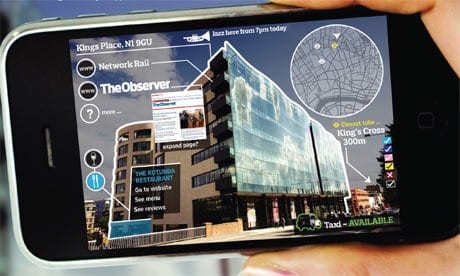In our previous article we examined what open source VR could mean for business. Alongside the rise of virtual reality, the tech world is also witnessing the rise of augmented reality. It is not meant to act as a competitor to virtual reality, but instead offers something different; essentially it is a middle-ground between virtual reality and real life. However, while virtual reality is primarily being used for gaming and businesses seem slow on the uptake of virtual reality into their business plans, augmented reality offers a real competitive edge to its counterpart.
This article is part of our series of articles below on “VR for business”:
- The History, Rise & Fall of Virtual Reality
- Has Oculus Lost the First Generation of Virtual Reality to HTC
- How Marketers Can Use Virtual Reality
- Virtual Reality vs. Augmented Reality & the Applications for Business
- Open Source Virtual Reality and What This Means for Business
- Virtual Reality Web Design; Why Every Business Will Need to Factor VR into Their Digital Marketing
- Virtual Reality eCommerce & the Future of Online Shopping (vCommerce)
- The Lowdown from Our VR Gurus, Rob and Adam
We would love to encourage some discussion and debate around where this interesting and game-changing technology is heading, so please feel free to leave us a comment below or on social media and we’ll get back to you.
In this article we will discuss the similarities and differences between virtual reality and augmented reality, and what their applications are for businesses below.
Virtual reality and augmented reality: what’s the difference?
Virtual reality is about transporting the user into an entirely different environment from the one they are currently in, essentially taking them out of the moment. It’s the next natural step onwards from 3D flat-screen televisions and Blu-ray games consoles.
It also perfectly complements technology like this. People play on games consoles or visit the movies to be taken into a different reality for a few hours; it’s why concepts and ideas such as Game of Thrones, which while do have historical influences, bear no real resemblance to the modern world and yet are so successful.
Virtual reality, especially alongside companies such as Open-Source Virtual Reality, will allow users to do almost anything in their new worlds. The possibilities are obviously amazing, but this mind-blowing positive for virtual reality may also be its downfall; you’re required to set some time aside to go into your new world, put on a headset and forget about everything else you have going on for a few hours.
Augmented reality, on the other hand, is more a merging of your real life with a virtual one, and most importantly, doesn’t require a headset. It’s the integration of digital, virtual information into the user’s real environment around them.

An example of augmented reality – credit: The Guardian
A perfect example is when Pepsi Max implemented augmented reality technology into a bus shelter which involved giant robots, tigers roaming the streets and even UFO abductions.
Some viewers reactions, in which they ran away from the bus shelter, perfectly show just how close augmented reality can get to real life. However, had this same experience been in virtual reality with a headset, chances are you wouldn’t turn and run. There are also examples of augmented reality being used in business here, in which we see things such as women being able to change the shade of makeup on-screen to find the perfect cosmetic item for them or American Apparel allowing consumers to find the perfect coloured product to purchase.
However, augmented reality can never reach the depths that virtual reality can, and people know this. Virtual reality isn’t trying to be augmented reality and vice versa. If people want their lives altered slightly or made easier in some way, augmented reality is the answer. But it’s like watching a movie on your smartphone or at the cinema, if you want to be taken out of the moment and connect with an alternative reality on a new level, then virtual reality is the only true option.

Augmented Reality – image credit: Flickr
What does this mean for business?
Virtual reality and augmented reality are both going to offer something entirely different for businesses. The virtual reality/augmented reality shift that we are seeing is the fourth major platform shift after PC, the web, and mobile phones, and each of these previous platforms has transformed the way business works forever, so it’s highly likely we’ll see the same thing from virtual and augmented reality. In the same way, businesses are now marketing both online and offline, they too will need to adopt and market through both virtual and augmented reality.
Virtual reality is going to allow users to immerse fully in whatever it is that the business would like them to be involved with. If an estate agent is trying to show a prospective couple around a virtual house, an augmented reality isn’t quite going to do it justice. But as we discussed earlier, this is where virtual reality becomes limited. A user will put some time aside, put on their virtual reality headset, have a look around the potential new home and then remove the headset once they’re done to return to their everyday lives. They’ll go back to using their smartphones and laptops with the possibility of not needing to put on their virtual reality headset for the rest of the day.
Augmented reality, however, can slot straight into your smartphone or laptop. We won’t have to think actively about using it to make our lives easier; it’ll be there already; much in the same way as we just assume we’ll easily be able to access the internet on our smartphones. Augmented reality enhances our daily lives; virtual reality takes us away from it. We examined what uses virtual reality could have for businesses and marketers in one of our previous articles, but just what could augmented reality offer? Some current uses include things such as education and training guides, maps services, digital tours and adding an extra layer to online shopping. Some websites list other advantages such as allowing businesses to adopt new strategies, creating engaging content and more in-depth guidelines or instructions. There are even uses for augmented reality in the United States Air Force, clearly showing the scale of the technology.
Both technologies are going to offer something different for businesses. It’s not so much about comparing them both and asking which one to use; it’s about looking at what strategy to use for virtual reality and which one to use for augmented reality. Either way, both technologies offer something more than is currently available by allowing consumers to connect on a deeper level with that business. Customers will be much more likely to buy from a business that they feel personally connected to.
How will AR and VR impact businesses?
It’s hard to truly get a feel for the differences between virtual and augmented reality until they both become more mainstream and are more widely accessible to the general public. Articles such as this one from TechCrunch describe the virtual/augmented reality business models as though it were one, rather than looking at in-depth comparisons of the two. While of course there are plenty of articles readily available on the differences between the two, no-one truly knows what impact these two technologies are going to have on the business world just yet, and many in the tech world are waiting and watching with eager eyes.
It’s clear, however, that both will offer something for businesses. They are going to allow companies to connect on a much deeper level with consumers, and showcase products and services in a way that they haven’t previously been able to. Those that don’t trust shopping online but don’t have the time to make it to the physical shops will find their shopping lives much, much easier, and as virtual and augmented reality technology grows, it is likely that this will become the third solid way in which people choose to shop. Businesses will need to stay on top of, or ideally ahead of, this trend, and adopt both technologies effectively into their marketing and sales strategies or risk falling behind the competition.
As we said earlier, virtual and augmented realities are the fourth major platform shift of our time, and each of the platforms before this, PC, the web and mobile phone revolutionised the business worlds, so just what kind of impact will these new alternative reality technologies offer? While it’s difficult to predict it entirely, with major players such as Facebook, Google, HTC, Microsoft and Sony behind these technologies, it’s certain that the impact will be heavy-hitting and widespread.

![Seo content creation guide for good content - why good content matters: seo content creation guidelines [updated] Seo content creation guidelines for good content](https://www.opace.co.uk/wp-content/uploads/2024/03/SEO-content-creation-guide-for-good-content-150x150.jpeg)




0 Comments